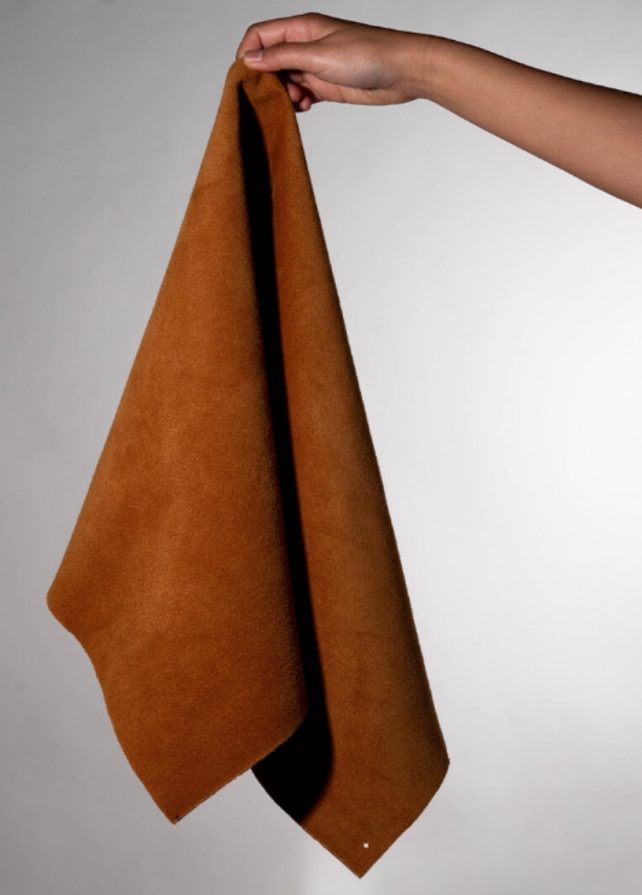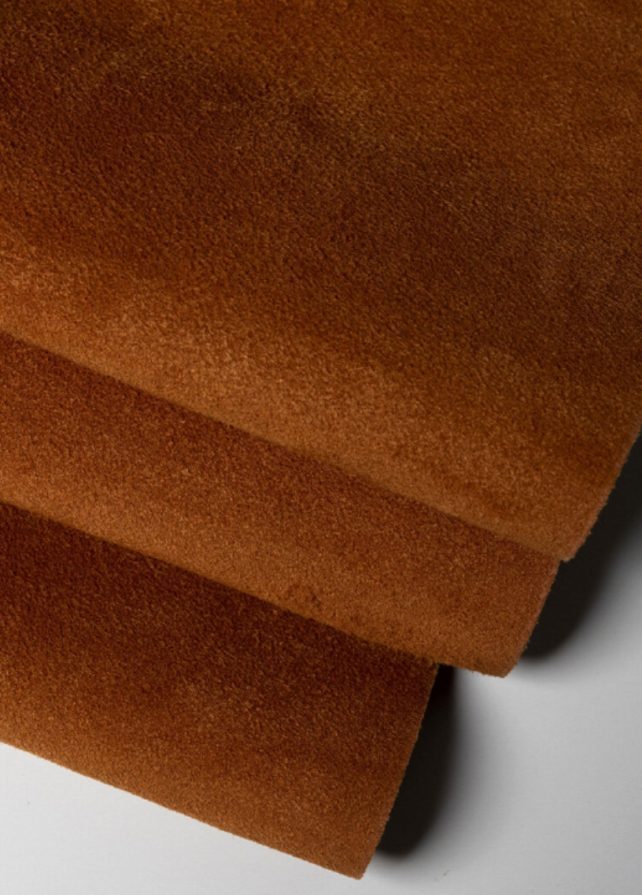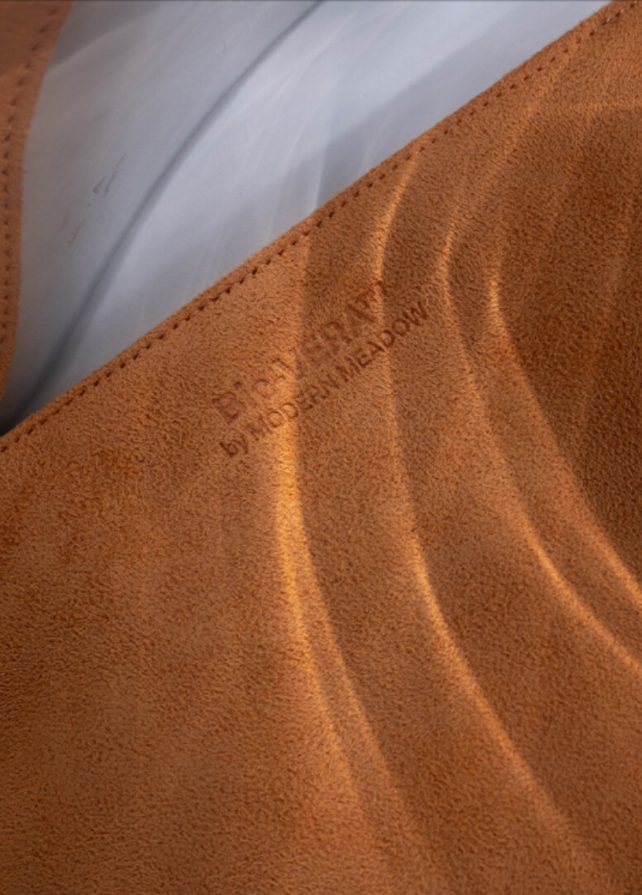Green Is the New Black: The Fashion, Function, and Circularity of BIO-VERA The - Première Vision Paris
[Sponsored content]
On their own, materials are often deceptively underwhelming. To the average observer, raw acrylates are little more than foul smelling, colorless liquids with no discernable value. Yet, acrylates form the basis of many consumer goods, from contact lenses to cosmetics and art supplies. When in the right hands, these banal liquids can be a medium for transcendent art, binding and manipulating pigments at the tip of a painter’s brush. Put simply, a material’s value is greater than the sum of its parts. Instead, the true value of a material is determined by its application, whether its facilitating artistic expression or combating global warming.
Such is the case with BIO-VERATM by Modern Meadow, a high-performance, versatile soft surface material derived from soy proteins, upcycled post-consumer tires and a revolutionary Bio-Alloy™, BIO-VERATM is a sustainable material that possesses a unique combination of material resilience and beauty which is emerging as an increasingly valuable material in the modern consumer landscape. These qualities have drawn the attention of designers across the fashion industry, including those in the automotive sector.

On the heels of the hottest decade in recorded history, nations around the world are cracking down on greenhouse gas (GHG) emissions. This necessarily includes a holistic reimagining of automobile manufacturing, whose products account for roughly 15% of global GHG emissions [ref]. Approximately 80% of these emissions occur when vehicles are being used (so called tailpipe emissions), but the remaining 20% can be attributed to the sourcing, distribution, and disposal of materials [ref]. Naturally, traceable materials with a low-carbon footprint have become a priority for leading manufacturers [ref, ref, ref].
However, developing such materials has proven difficult as most synthetics struggle to meet the automobile industry’s substantial performance and manufacturing requirements, much less do so while retaining consumer appeal. BIO-VERATM has the potential to succeed where others have failed, ultimately helping manufacturers reduce GHG emissions while evolving to meet the growing market demand for fashionable, high-performing, and animal-free products.
Fashion and Function in Automobiles
“The automotive industry is a fashion business,” explained Jon Lauckner in a recent interview. The former Chief Technology Officer at General Motors and President of GM Ventures, Lauckner has amassed more than 40 years of experience in automobile manufacturing and is acutely aware of the need to evolve while staying fashionable.
“The appearance and perception of a vehicle is critically important. Exterior styling is important, but the fact of the matter is: the interior of the vehicle is where you spend most of your time and it will significantly affect a person’s attachment to it.”
It’s appropriate then that the materials used to build vehicle interiors—such as the carpeting on the floor, the lining on the steering wheel, and the material adorning the seats—have evolved alongside fashion trends. To keep up with fashion, auto manufacturers invest heavily in the research and development of new materials that walk the fine line between fashion and function. For much of his career, Lauckner oversaw this process at GM Ventures.
“Aesthetics are critically important, but particularly for seats and door trim panels—high impact areas—you need material that can perform.” Typically, consumer vehicles will be in use for an average of 12 years [ref], during which time they may be exposed to high heat, frigid cold, and children (among many other abrasive forces of nature). Materials must keep up with it all, which according to Lauckner, means “strength, abrasion resistance, color fastness, and resistance to fading are all extremely important.”
Leather, with its water repellant and durable nature, is perhaps the ideal material for vehicle interior design. And the craftsmanship imbued by tanneries gives leather a characteristic beauty and tactile feel that charms consumers. Together, these features have made leather a timeless luxury material. But times are changing. While governments around the world incentivize manufacturers to reduce their carbon footprint, consumers tastes are shifting toward vegan alternatives and sustainably sourced products [ref, ref, ref]. It’s not surprise that top automobile brands have public commitments to adopt alternative materials to spur of GHG emissions reductions [ref, ref, ref]. Part of that commitment includes searching for viable leather-like materials.

BIO-VERATM: A Next Generation Material For Future Generations
Though novel textile research is perpetual in the automotive industry, few viable materials have surfaced that can match leather’s fashion and function. There are many possible reasons for this [ref]. Synthetic materials often use a woven microstructure that provides strength but detracts from its natural feel. Materials derived from organic matter and biologics may show valuable properties but require novel manufacturing infrastructure that greatly limits their ability to scale. And, beyond functionality, synthetic materials often lack the idiosyncratic design features that make natural materials unique.
But where countless materials have failed, BIO-VERATM is poised to succeed.
“BIO-VERATM has a very luxurious feel that seems indistinguishable from natural leather to me,” Lauckner explains. “It also has advantages that other materials have lacked: it’s an animal free biomaterial that has an extremely high amount of recycled materials; and it is made to be drop-in ready for existing manufacturing processes. Those are real big advantages.”
From a material perspective, BIO-VERATMTM is a non-woven soft, surface material that matches or exceeds natural leather in durability, color range, color fastness, and design flexibility. Head-to-head, BIO-VERATM has proven to be 2x stronger than leather and up to 25% lighter. By using both upcycled post-consumer waste and a plant-based alloy, BIO-VERATM also offers higher traceability and a lower environmental footprint.

Importantly, production of a final, leather-like material with BIO-VERATM can be achieved by integrating into late-stage tannery workflows. Time-perfected techniques that produce luxury leather are being used to produce BIO-VERATM without the need for chromium or other harsh tanning reagents. This means that BIO-VERATM has high drop-in capabilities, which allows manufacturers to leverage existing infrastructure and workflows when producing vehicle interior parts with BIO-VERATM.
Many manufacturers are interested in using circular materials to reduce GHG emissions —meaning that, upon a vehicle’s end of life, its component parts can be broken down and infused back into the manufacturing process [ref]. Such materials can substantially reduce the amount of waste entering landfills. BIO-VERATM’s composition is inherently circular and, in using upcycled tires, helps reduce the amount of carbon-heavy rubbers that reach landfills. It’s not surprising then that BIO-VERATM is in final testing stages with several automotive makers in North America, Europe, and Asia.
While navigating the path to carbon neutrality will undoubtedly be difficult, next-generation materials like BIO-VERATM ensure that the ride will not only be smoother, but a more fashionable one too.
Come meet the Modern Meadow team from 2 to 4 July at PV Paris
Hall 6, booth 6R6
To find out more:
Website: https://modernmeadow.com/
Instagram: https://www.instagram.com/modernmeadow/
LinkedIn: https://www.linkedin.com/company/modern-meadow
Our products on the PV Marketplace
Get in touch: Cheryl Cox
